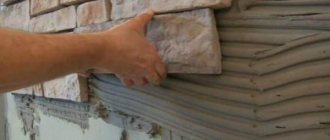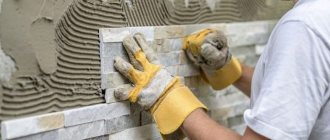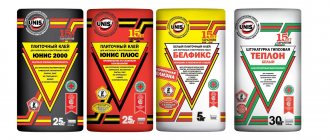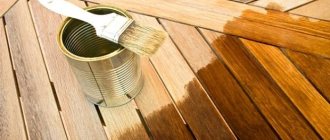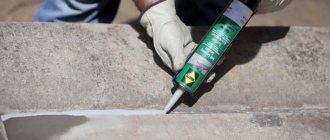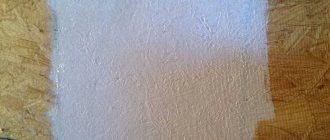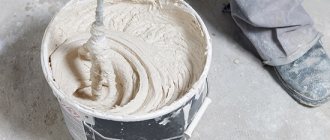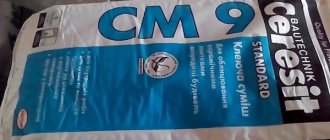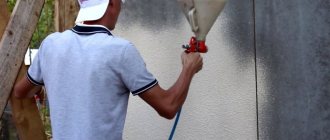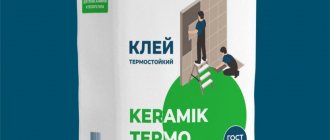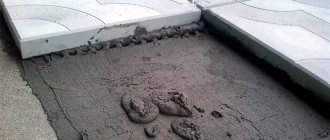Natural stone is a material that can not change its properties for many years, and it looks aesthetically beautiful. Porcelain tile gained popularity a long time ago, but over a long period it has not become less in demand. To get a durable finish, it’s worth knowing what is best for gluing granite. The ease of operation and quality of the result depend on the chosen tool. The types of adhesives for granite will be discussed below.
Choosing the right adhesive
Variety of construction adhesives
To follow all the recommendations, you need to choose the adhesive composition correctly. For gluing tiles on the floor, its viscosity does not matter much. For walls you need glue of special viscosity. In order to glue granite surfaces, you will need a transparent adhesive that does not leave marks. Adhesive compositions can be found in retail outlets and quite a lot. We should be interested in a composition at a reasonable cost and high quality. Let's look at some of them.
The most common option is based on cement with various additives. It is affordable and easy to use. The epoxy version costs 3 times more. It is frost-resistant, white or transparent. It is used for grouting joints, treating stones, lining fountains and pools, and laying mosaic paintings and transparent stones.
Ceresit glue is of good quality. But you can get a fake instead. For this reason, Ceresite has now fallen out of favor as an adhesive for marble and granite. It is better to purchase Unis Granite. Its advantages:
- the life of the finished solution is measured in three hours;
- it is able to withstand slabs up to 70 kg/m²;
- has high moisture resistance and frost resistance.
The basis is domestic products. It is frost-resistant and is used for finishing external wall surfaces. The product quality is very high.
Graniplix AC14 has a viability of 6 hours. It can be used at air temperatures from -50 to +70°C. Excellent frost resistance and long service life.
Knauf marble is a substance of good quality, time-tested. But it also costs a little more than other options. Used for finishing swimming pools and balconies, stairs and terraces, walls and floors.
a brief description of
Frost-resistant adhesive compositions for granite or marble products have a wide range of uses. They are actively used in the manufacture of marble and granite stone gluing, for decorating buildings and structures with original mosaics and inlays, and when processing seams on stone.
This glue is characterized by the following properties:
- provides the ability to use glued parts after an average of two hours;
- does not change its characteristics even with constant contact with ultraviolet radiation;
- demonstrates high resistance to alkalis or acids;
- remains effective when the temperature changes within the range from -10 to +100 °C;
- used for outdoor work, so it is frost-resistant;
- does not give in to compression, does not crack and does not change its color as it hardens.
How to choose tile adhesive
All types of adhesives last longer and reduce waste if used as intended - the solution will not crack, the tiles will not fall off, and harmful substances will not be released.
Choose adhesive based on external factors:
- Indoor climate
- determine humidity and temperature. - What will be in the base
: cement screed, drywall, wood, plastic, metal. - Sudden changes in the temperature of the base
- what kind of floors will be in the room: regular or warm. - What size and type of tile will it be
: porcelain stoneware, natural stone, tile; small or large size. : whether there will be high or low traffic.
Stroyholding services
Buy tile adhesive for finishing apartments, country houses and professional areas from us; For interior and exterior use. We sell tile adhesive wholesale and retail, delivering in Moscow and the Moscow region.
Today, much attention is paid not only to the interior design of the house. The external facade is like a business card of the owners; to create a noble, respectable appearance of the building, natural marble or artificial porcelain stoneware is often used
This type of tile covering is durable, easy to care for, and can be used to achieve a stunning aesthetic effect. The tiles have one drawback - the high weight of each product. Therefore, to attach it, it is necessary to purchase stable or frost-resistant tile adhesive for external use. There are several types of similar materials on sale: a wide range can confuse any ignorant buyer, so the question of which glue is best is very relevant for many consumers. This article will talk about the advantages and disadvantages of each composition, and about manufacturers you can trust.
So, on sale today you can find several compositions that can be used for tiles for outdoor use.
- Universal adhesives. They can be used for cladding the interior walls of a house and for facade work, but they can only be used to glue tiles no larger than 30x30 cm in size.
- Strengthened adhesives. They contain components that can provide high adhesion to the substrate. Reinforced mixtures can be used for both internal and external work. It is advisable to purchase them if natural stone or any other tile material that can withstand high static and dynamic loads is used as a finishing material. The best base for such adhesives is the floor. With their help, it is easy to create a cladding that can withstand both high dynamic loads and the pressure of heavy objects. Reinforced compounds tolerate temperature changes and high humidity thresholds well.
- Specialized mixtures. Let's talk about them in more detail.
Cheap offers
Based on cement, another adhesive for stone for outdoor use is created - Ceresit cm14 extra. It costs 260 rubles. for a 25 kg bag and is able to withstand the impressive weight of finishing materials. Professional quick stone glue is in the same price category; you will have to pay 247 rubles for it. Adhesion to concrete indicators are 0.5 MPa. Frost resistance – 75 cycles. The composition can be operated over a wide temperature range – from -50 to +70°C. Depending on the condition of the surface, you will use a maximum of 15 kg of finished glue per square meter.
Glue for natural stone is somewhat more expensive - “Ecobond” - 310 rubles. It has increased adhesion to concrete, which reaches 1.5 MPa, the composition can be used when facing walls with heavy natural stones. Frost resistance is slightly lower than that of the mixture described above, and is 50 cycles. After preparation, the glue can be used within 4 hours.
An alternative solution would be Litokol litoelastic, which costs around 3,274 rubles. for 5 kg. This two-component composition is designed for laying natural stone on vertical and horizontal surfaces. The mixture is created on the basis of epoxy-polyurethane resins, inert fillers and organic additives. The catalyst is an organic base with fibers. This glue is very expensive compared to others, but is of high quality, so it is used for finishing the most prestigious buildings. You can use a variety of materials for installation, and even metal can act as a base.
If you need frost-resistant adhesive for stone, then you can pay attention to Eunice Granite, which can withstand stone of impressive weight. This glue, the price of which is 370 rubles per 25 kg, is used for finishing facades, fences, entrances and plinths
The composition can be used for finishing on concrete and brick load-bearing surfaces. A mixture “Knauf Marble” was created especially for marble, which costs 375 rubles. for 25 kg and is characterized by high aggressive abilities towards brick and concrete. This glue holds slabs weighing 40 kg per square meter.
Another frost-resistant adhesive for stone for outdoor use is Litokol x11. Its cost is 325 rubles. for 25 kg. The mixture can also be used for interior work. It can withstand about 40 freeze-thaw cycles. Consumption will depend on the condition of the surface and reaches 5 kg per square meter. Almost the cheapest composition on the market is Glims Grayfix, which costs 225 rubles. for 25 kg. The base material for the walls can be concrete and brick. The glue is made based on water and cement. It is frost-resistant and allows you to adjust the position of the tile within 20 minutes after gluing it.
Review of popular brands of glue for tombstones
There are several products included in our rating, and our commentary will help you choose one or another product, a feature due to which customers often prefer this product:
| Rivo-15 Nero from Tenax | Suitable for installing a monument in Moscow and St. Petersburg, since it has an operating temperature of -25 to + 60 degrees. The glue is already painted black, so it is perfect for gabbro monuments. Advantage: low price (compared to other professional epoxy adhesives for natural stone). black thick 1+1l beige thick 1+1l |
| Domo-10 from Tenax | The glue is suitable for cities where the thermometer drops to -50 degrees. Has increased adhesive strength compared to other epoxy compounds. black thick 1+1l white thick 1+1l |
| Akepox 5010 from Akemi | Usually used when it is necessary to make the adhesive connection as inconspicuous as possible; the adhesive is transparent in a thin layer, perfect for restoring chips on a monument. Disadvantage: High price. transparent thick 1.5+0.75kg |
Review of famous manufacturers
Today there are many companies that make adhesives for stone and other materials used for finishing. This allows you to choose the appropriate option.
Keralastic T
This substance includes 2 components. It is characterized by ease of use, high elasticity and durability. The composition does not shrink and is characterized by excellent waterproofing characteristics. It does not contain water or solvents.
The product is often used for outdoor work. It helps to lay tiles on unstable surfaces. The composition also helps to glue stone to coatings that are subject to vibration and deformation.
Keraflex
The product is a dry mixture. It consists of cement, sand, resins and various additives. To use the substance, water is added to it. The product is suitable for wall decoration. The adhesive composition is characterized by high elasticity and excellent adhesion.
Eunice
This dry composition is characterized by high resistance to moisture and negative temperatures. The brand's product range includes many types of materials. They should be selected taking into account the operating conditions and type of surface. The composition is suitable for laying stone on a rough surface. It is characterized by a high degree of adhesion. The substance can be used even in unfavorable conditions.
Kreps plus
This substance is a dry composition. It contains cement and sand. The substance also contains modified additives. After combining with water, a plastic mass is obtained that has excellent thixtotropic characteristics.
After hardening, the composition becomes very durable. It is characterized by high resistance to moisture and low temperatures. The substance is actively used for laying tiles and stone. It can be used for indoor and outdoor work.
Elastorapid
The substance is available in the form of a dry mixture. It includes sand and artificial resins. The adhesive is suitable for finishing rooms with high traffic. The substance is used for vertical coatings and can withstand a wide range of temperatures.
Advantages and disadvantages
The adhesive composition of liquid nails has both positive and negative qualities.
It’s worth starting with the cons - these are:
- Strong unpleasant odor.
- Not suitable for application at low air temperatures.
- It can only be applied in rooms where there is good ventilation, since the composition is toxic.
The list of advantages included many more characteristics of the glue:
- Allows you to glue tiles to walls of any degree of porosity.
- Liquid glue has a special composition that quickly hardens within 10-40 minutes.
- It is used for sealing seams and joints in rooms with high humidity, so it is suitable for the bathroom, kitchen, and swimming pool.
- The high strength of the substance guarantees the durability of ceramic or other material finishes.
- Provides ease of use, which is a huge plus for inexperienced craftsmen.
Related article: Which tile adhesive is better? The best brands and tips for choosing quality glue
How to do gluing
According to the manufacturer's instructions, to obtain a neat and durable seam you will need to perform the following steps:
- First, you should clean the surface of the material from existing dirt, dust, bitumen residues and grease. To do this, you can use rags, special chemicals and a construction vacuum cleaner. If granite or marble has too obvious cracks or other defects of a similar nature, they will need to be eliminated using a special plaster mortar for natural stone. Next, the material is coated with a primer to increase adhesion. These types of work must be performed in a room with an air temperature ranging from +5 to +25°C;
- at the second stage, a glue solution for marble is prepared. To do this, the dry mixture must be poured into a previously prepared container. For example, a construction basin. It is filled with water. The components should be thoroughly mixed until a homogeneous mass without lumps is formed. If you use a special construction mixer, this takes about 5 minutes on average. This homogeneous adhesive solution for exterior use should be used within 3 hours after preparation. Otherwise, it will lose its properties and be less effective;
- the resulting homogeneous mass is applied in a thin layer to the surface of the granite slab and combed using a notched trowel. The second surface to be glued must be evenly applied to this layer and pressed down. The process will be effective if more than 80% of the surface of the material being glued is covered with glue;
- The surfaces to be glued will need to be pressed tightly against each other for a while and left until the composition has completely dried.
The video below provides detailed instructions for using glue for marble and granite.
How to glue granite to granite
Unfortunately, there are situations when the material is damaged (a corner is broken off, etc.) and people do not know how to glue granite to granite. I am very glad that in some cases the stone can be restored without losing its decorative effect. For this, a special adhesive for granite is used, usually a polyester composition, for example, Bellinzoni MASTICE 2000, the main advantage over epoxy materials is rapid hardening (from 3 to 6 minutes).
Various versions of glue are available, with which it is easy to glue granite to granite: colorless, honey transparent, black, white, green, beige, etc. After gluing, the surface is sanded and the seam is practically invisible.
How to choose the right one
High-quality cladding can be performed provided that the brand of glue is selected correctly. The adhesion strength of the stone to the base, and therefore the durability of the work done, will depend on this. Each option requires its own brand of glue, which must correspond to the type of cladding and type of stone. Stone tiles have different thicknesses and sizes.
For facade work, the adhesive must have:
- vertical retention rate of 70-80 kilograms;
- frost resistance to freezing and freezing at least 35 times;
- waterproof qualities;
- withstand low/high temperature cooling/heating;
- color matching.
Marble slabs are glued with colorless glue.
Species diversity
All adhesives offered by modern manufacturers can be divided into the following types:
- Polyester mastics: have many color shades, due to which they are actively used for decorating marble facades of buildings and structures. Such compositions are produced in three states - liquid, semi-liquid and solid. The choice of a specific type will depend on the characteristics of the stone parts that will need to be glued together;
- Epoxy adhesives: often used in modern construction and characterized by a high level of strength. Such two-component compositions are suitable for gluing granite and marble parts, as well as iron and concrete products;
- Exterior Epoxy Impregnants: Designed to fill small pores, scratches and other imperfections in stone surfaces. They are very effective as they exhibit low viscosity. Easily filling the pores of the stone, frost-resistant epoxy impregnants are very easy to grind. Therefore, they are mainly used for outdoor work.
How to choose the right one
What to look for when choosing an adhesive for granite:
It is important to consider that granite is heavy, so the glue for it must have excellent strength and increased adhesion. The expansion of stone and cladding at different temperatures can have a significant difference, and a high-quality adhesive composition must compensate for this so that damage does not occur. The glue must resist moisture and not be afraid of temperature changes, to which building facades are constantly exposed. The viability of the adhesive mixture must be long, since working with granite is not very easy due to the existing uneven edges.
The viability of the glue after mixing should be at least 3 hours. The frost-resistant composition used from the yard can withstand at least 35 freezing cycles.
It is also important that the product holds massive stones, such as granite. Good glue does not drain from vertical surfaces, because this has a bad effect on the final adhesion of dissimilar materials
When buying glue for working with granite, you need to carefully read the instructions. The packaging contains almost all the information to understand whether the product is suitable for the desired purpose. It also describes the material consumption and optimal conditions for cladding or other work.
Source (full version): https://gidpokraske.ru/vidy-kleya/kleya-dlya-granita-dlya-naruzhnyh-rabot-morozostojkiy.html
How to install a granite vase in a cemetery?
The granite vase is fixed with glue and a pin. The pin must be at least 8 cm in length and 6 mm in diameter. Half the pin should go into a solid surface, half into the vase. That is, the pin can be “driven” into a slab, plinth or tile, or it can be cemented if the place for the vase needs to be arranged separately.
Interesting materials:
Why do mushrooms grow near the road? Why do zucchini turn yellow and not grow? Why do onions grow small? Why does parsley grow slowly? Why do many mushrooms grow near trees? Why do mushrooms grow on trees? Why don't trees and shrubs grow in the meadows? Why doesn't the rubber plant grow? Why doesn't the yucca palm grow? Why doesn't lettuce grow in the garden?
Types of glue
The mixtures with which natural stones are glued together today can be divided into the following groups.
Polyester type
This category includes liquid, solid, semi-liquid glue. They have many colors and shades, so they are often used indoors, for outdoor use, and for fastening porcelain stoneware.
The most famous representatives of this group:
- Tenax Solido Quarzo - it can be used to securely fasten granite tiles to any surface, as well as laminate stone;
- Bellinzoni Mastice-2000 is perfect for interior decoration; it can be used when making mosaics.
They are not frost-resistant, so in our climatic conditions they are not intended for outdoor use.
Two-component epoxy compounds
Two-component adhesive is highly durable. It is suitable for gluing granite tiles to concrete, for connecting concrete to iron. This composition can easily repair a stone product or fasten marble or granite parts. This product will last for many years.
Two-component compositions include two ingredients - the glue itself and the solvent for it.
The most famous representatives of this group:
- Akepox 1005 - designed specifically for gluing cracks and chips that appear on the surface of tiles or stone products;
- Bellinzoni - heavy-duty, chemical resistant;
- Isomat Ak-epoxy Normal - glues stone and other surfaces.
Despite the high cost, this glue is in constant demand due to its qualities. It “works” in difficult climatic conditions, including frost, allows you to restore stone that seems hopelessly damaged, and is easy to use.
Impregnants
This type of glue is ideal for outdoor use as it is frost-resistant. The advantage of this product is its ability to fill stone pores, cracks, joints, seams, and is easy to grind and polish after hardening.
Representatives of the Bellinzoni brand:
- Aquapox;
- Imprepox.
Both products are characterized by high fluidity, which allows them to penetrate into the smallest cracks and strengthen the stone. Very durable after hardening, not susceptible to chemical attack, frost-resistant.
Cement
Cement-based adhesives may or may not be frost-resistant. This point must be clarified when purchasing.
The most famous of them are Ceresit, Unis Belfix, reinforced frost-resistant adhesive Unis Granite, Graniplix, Knauf (created for any temperature).
When deciding how to glue marble and granite, you need to proceed from the characteristics of the adhesive composition, the type of surface to be glued and the type of work.
Requirements for the adhesive composition
Different types of stone have different technical characteristics and operational parameters. For example, granite is very hard and weighs a lot, while limestone is looser; marble is quite dense and contains many different mineral components. In this regard, stone adhesive must be suitable specifically for a specific material, have the highest adhesion force to it, and penetrate deeply into the pores.
Other requirements that the glue must meet:
- The composition must be ideally suited for specific conditions of use or be universal. There must be permission to use it for external and internal work. Some products are applied to stone slabs for gluing to the surface, while others allow you to seal seams and restore chips in the stone. This point is important to consider when purchasing.
- If the adhesive is to be applied to external substrates, it is better that it can withstand any temperature without problems and can be used even in harsh conditions.
- Glue for granite or other stone must be durable and not be destroyed by chemicals, sunlight, or atmospheric moisture.
- Good glue lasts for many years, does not crack, does not lose its original properties, does not change its appearance, shape, color or texture.
- The hardening speed of the glue should be quite high. This will allow you to start using the product after a short time.
Frost-resistant adhesive for granite for exterior use: which is better?
Manufacturers offer all sorts of options: some save the consumer money, others have improved characteristics, but are significantly more expensive. Ultimately, we are interested in good quality at a reasonable price. We suggest starting with a market overview to avoid mistakes.
- The most common mixtures are cement-based with special bonding additives. After hardening, they form a strong monolithic joint. The cost is affordable, they are easy to use, they completely fill voids if the technology is followed, thereby reducing the risk of damage to the facing material or its peeling during operation.
- Epoxy compounds, or two-component adhesives for granite, are much more expensive, about 3-4 times, have increased adhesion, frost resistance, and are usually transparent or milky white in color. They are used for grouting joints, treating stone, or in difficult operating conditions: with high humidity, in open areas (pools, fountains, facades, etc.). They are also used for laying mosaics and transparent onyx stone.
Let's take a closer look at products from different brands to determine what materials are needed for different conditions of use.
Cement frost-resistant adhesive for marble and granite for exterior use
Cement mixtures necessarily differ in their area of application: for interior and exterior work, do not forget to check with the seller about the type of glue. Among the many brands, the most popular are:
Ceresit - by winning in price, you can get good quality. However, more and more often on the market you can find low-quality products in the form of fakes, which is why many craftsmen began to abandon this brand of frost-resistant granite adhesive for outdoor work.
Unis are practical and reliable materials, proven over years of practice.
For exterior work, it is worth purchasing reinforced frost-resistant adhesive Unis Granite:
- The lifetime of the solution (while installation and adjustment work can be carried out) is 3 hours.
- Withstands slabs weighing up to 70 kg per m2, retains its properties at low temperatures, does not absorb moisture after setting, which ensures maximum adhesion force for many years.
- Equally good for laying floors and wall decor, the tiles do not slip on vertical surfaces.
- Frost resistance 35 cycles.
- At the same time, the price remains affordable, approximately 400 rubles. per bag packed 25 kg.
By choosing Unis brand granite adhesive for outdoor use, you get an excellent price/quality ratio and can be confident in the reliability of the material.
Osnovit is a granite adhesive for exterior use that is frost-resistant and moisture-resistant; it is a fairly high-quality domestic product with enhanced characteristics.
You can choose the Graniplix AC14 series adhesive, which has excellent properties:
- The viability of the finished solution is up to 6 hours.
- Withstands temperature loads during operation from -50 to +70 °C.
- The time for adjusting the slab is up to half an hour.
- Frost resistance up to 50 cycles.
- The cost is approximately 360 rubles. per bag 25 kg.
It is used both for laying facades and in wet operating conditions: for swimming pools, dressing rooms, fountains.
Knauf is a granite adhesive for exterior work of good quality, time-tested, but the cost is slightly higher: the Knauf Flex mixture will cost about 560 rubles. per bag 25 kg.
- Frost resistance 150 cycles.
- It is used on any surfaces indoors and outdoors (including the basement): vertical and horizontal, for cladding swimming pools, terraces, balconies, steps, stairs.
- Permissible load (weight of slabs) - up to 50 kg per m2.
By choosing among the considered brands of frost-resistant adhesive for granite for exterior use, you can find the best option for your conditions, to fit into your budget and not skimp on quality.
Rating of the best brands
Brands based on cement, polyester, and epoxy resins are in demand.
Unis Granit
Composition: cement, mineral and chemical additives. We recommend for use in temperatures not higher than +30 and not lower than +5 degrees. Purpose: fastening large-format slabs of natural and artificial stone on building facades.
The basis may be:
- concrete;
- gypsum;
- brick;
- cement;
- asphalt.
The viability of the solution is about 5 hours.
Litokol Litoelastic A+B
Epoxy adhesive belongs to the reactive, two-component class, which includes a resin and a hardener. It is used in civil and industrial construction for cladding vertical and horizontal surfaces. It has increased strength and frost resistance.
Professional Quick Stone
The adhesive composition is resistant to temperature changes from – 50 to + 70 degrees and has good adhesion. Purpose: cladding facades with natural stone.
Cement-based adhesive for external and internal cladding of floor coverings, stairs, plinths and facades.
Tenax Solido Quarzo
Polyester adhesive-mastic from an Italian manufacturer. White paste that can be tinted with Tenax dyes. Purpose: for cladding horizontal surfaces, repair, reconstruction of compositions made of natural stone.
Bellinzoni Mastice-2000
Polyester mastic cream from the Italian company Bellinzoni has a wide range of colors and is applicable up to a temperature of 0 degrees. Available in liquid and thick consistency. Purpose: working with natural and artificial stone.
Akepox 1005
Liquid epoxy glue. Used for laying and repairing light natural stones. Resistant to weathering and low temperatures.
Isomat Ak-epoxy Normal
Epoxy adhesive made of 2 components, does not contain solvents. Used for cladding floors and walls, on all types of surfaces, for external and internal work.
Aquapox
The adhesive has ultra-high fluidity, colorless, based on resins and a hardener. Recommended for external gluing with granite or marble. The composition is resistant to aggressive environments.
Imprepox
Liquid adhesive based on epoxy. Manufacturer: Bellinzoni. Scope of application: surface restoration and gluing of all types of natural and artificial stones.
Areas of application
In recent years, the use of natural stone in construction work and interior decoration of residential and office premises has become increasingly popular.
Marble and granite are very popular materials used in construction and finishing of building facades. In addition, this material is actively used to create furniture, interior accessories and stairs. However, without the use of a reliable adhesive composition, working with marble and granite slabs is simply not possible. That is why glue for natural stone is an extremely necessary and effective tool.
adhesive for granite and marble
By the way, you can buy glue for granite and other surfaces here: https://diammarket.ru
Granite or marble require the most careful handling. To join products made from these materials, you need a special adhesive composition that can provide the bonded surfaces with high efficiency, durability and resistance to environmental influences, but at the same time will not be too aggressive.
Glue for wild, facade stone. Features of work
Glue for wild, facade stone does not require pre-soaking of products. The base must be cleaned of grease and dust; leveling is not required. Natural stone adhesive can also be used to level the surface, simultaneously with laying facing materials. Plitonit B+ stone adhesive
with high adhesion strength to concrete.
The bases on which stone or tiles are laid must be pre-treated with a primer to reduce the degree of water absorption. Make sure that the surfaces do not have cracks or delaminations. To eliminate defects, special Plitonit levelers are recommended.
The “warm floor” system can be put into operation no earlier than 7 days after the completion of finishing work. For finishing fireplaces and stoves with natural and artificial stone, high-temperature heat-resistant stone adhesive Plitonit Superfireplace
.
The stone adhesive is mixed with clean water at room temperature. It is NOT ALLOWED to add water to the mixed solution! Despite the complete safety of Plitonit mixtures for the skin of the hands and body, avoid splashing the solution into the eyes and mucous membranes.
Gluing tiles to the wall
Gluing tiles to the wall with glue
To glue the facing tiles, the walls need to be prepared. To do this, all dirt, dust, and construction debris are removed from them. Pronounced defects must be corrected with plaster. Next, prepare the adhesive mass. If necessary, the substance is diluted according to the instructions. This must be done in a container, which will then have to be thrown away.
The finished frost-resistant adhesive is applied in a thin layer to the wall surface. After this, a marble tile is taken and also smeared with glue. All that remains is to connect both surfaces. Marble or granite tiles are quite heavy, so you need to hold them a little until the glue polymerizes. In order for the results of the work to please the owners for many years, it is necessary to strictly follow all the recommendations listed above.
Most popular brands
There are many adhesives available on the packaging that say they are moisture-resistant and frost-resistant. Below is a list of adhesive compositions that have earned good ratings from experts and users.
PC brand "Flizen" from
"Knauf"
is a well-known manufacturer of building materials from Germany. For external tiling, for example, Knauf Fliesen is suitable. Dry mixture based on cement. Withstands twenty-degree minus temperatures. The number of cycles is 50. The Knauf Flex mixture has a larger number of cycles (100). Unlike Flizen, Flex has no restrictions on the size and weight of the tiles. "Flex" has high water-repellent qualities. It is recommended to be used, in particular, for cladding the roofs of indoor swimming pools.
"Litostone K98/K99"
Dry mixture from . Grade K98 is made on the basis of gray Portland cement. Used for laying natural stone, granite, dark marble, basalt and KP. K99 is produced on the basis of white cement. Used when working with white marble, shell rock, travertine. The glue dries quickly and can withstand high loads. Operating temperature range from -30 to +80 degrees.
"Foundation Graniplix"
Used for cladding terraces, balconies, facades and plinths. The base is cement. The mixture performed well when used in wet conditions (swimming pools, etc.). You can attach porcelain stoneware and other materials weighing up to 800 grams.
"Weber Vetonit"
Glue is available. Several frost-resistant brands are known. For example, the Granite Fix brand is used for fastening porcelain stoneware and any other tiles. Used on almost all substrates (cellular concrete, brick, cement-bonded particle boards, etc.). Characterized by a very high degree of adhesion and elasticity. High frost resistance – 150 cycles.
The Ultra Fix Winter brand is also distinguished by its very high frost resistance. It can withstand cold up to eighty degrees.
"Unis 2000"
Product made in Russia. Suitable for different bases. Operating temperature from -20 to +50 degrees. Frost resistance is about 100 cycles. The glue is capable of holding weight up to 50 kilograms per square meter.
White "Hardfix"
"Hardfix"
Produced by Russian. “Hardfix” is used at sub-zero (down to – 10 degrees) temperatures. Very good resistance to water. The base of Hardfix is cement. In addition, the mixture contains fractionated sand and modifying additives that allow working with the solution at subzero temperatures.
"Ceresit"
"Ceresit"
A very well-known brand in the building materials market. The brand belongs to a company that has been producing various building materials for over a hundred years. “Ceresit SM17/SM117” perfectly holds not only tiles, but also other facing materials. Brand CM17 is intended for operation in the range from -50 to +70 degrees. Frost resistance reaches one hundred cycles. CM117 has the same frost resistance. The difference between brands is that the second adhesive holds heavier weight material.
Facade cladding with clinker tiles
Clinker and porcelain stoneware
Speaking about mixtures for outdoor use, we cannot fail to mention clinker tiles and ceramic granite. The fact is that only these types of ceramics are suitable for installation in unfavorable (primarily in terms of temperature) conditions. Regular tiles are too porous, which leads to high water absorption. Water at zero temperature turns into a solid state.
On the left is the structure of ordinary porcelain tiles, on the right is clinker tiles. Due to the presence of pores, clinker tiles remove moisture and do not crack in the cold.
Thus, when solving the problem of choosing an adhesive mixture, we are faced with polar problems. The glue must simultaneously provide excellent adhesion (in conditions of low porosity), be elastic for negative temperatures and withstand repeated (often sharp) temperature changes. But you already have a guideline; modern technologies solve all core problems. The tiler is required to make a competent choice and strictly adhere to technological processes.
The street and low water absorption of porcelain and clinker tiles require some additional effort on the part of the tiler. If when laying ordinary ceramics it is enough to apply glue to one element (base or ceramics), then be sure to coat both elements. This increases the consumption of the mixture slightly, since in one case you can limit yourself to a very thin layer. Apply glue and immediately remove with a spatula. The remaining mixture enhances adhesion like a primer.
What to pay attention to
The composition must have excellent adhesion and not change the original properties after hardening. It is not recommended to use universal mixtures, because in terms of frost and moisture resistance they are not able to satisfy the requirements for mixtures that should be used in conjunction with natural stone. This is especially true for cold climates, where operating conditions are the most difficult.
When choosing a glue brand, experts recommend paying special attention to the manufacturer. Those located in northern countries take into account the frost resistance factor and produce adapted adhesives
Domestic companies today have mastered the technology for producing high-quality mixtures. In all respects they are not inferior to imported analogues. However, the cost of Russian-made products is not much lower than foreign ones. The cost is sometimes unreasonably high.
Choosing reliable adhesive liquid nails - review of proven options
When choosing the most suitable brand of adhesive, consider the following:
- What materials need to be glued;
- What load will the adhesive seam experience?
- Under what conditions will the glued product be used (indoors or outdoors).
Today, the most popular among professionals are adhesive liquid nails from such manufacturers as: Moment (Henkel), Titebond, Makrofix, TYTAN, Krass, Kim Tec, Liquid Nails, Kraftool, Titebond, Quadro.
The following brands enjoy a very good reputation:
Glue Moment Installation MV 50 liquid nails is a universal moisture-resistant express adhesive based on water dispersion (polyacrylate).
Excellent for joining different surfaces (wood, styrofoam, metal, plastic, ceramics, chipboard, MDF, cork, foam, plaster, etc.) when carrying out installation work indoors and outdoors.
Ideal for gluing plastic and wooden skirting boards and other decorative elements, various profiles and panels indoors.
Liquid nail glue Titan Professional 901 is a heavy-duty construction and installation adhesive based on hydrocarbon solvents.
Provides strong and quick bonding of various types of surfaces (wood, metal, ceramics, concrete, plastic, stone, etc.). Resistant to temperature changes and high humidity.
Suitable for outdoor use (frost-resistant). Titanium Professional 901 is suitable for gluing heavy decorative elements and building materials.
Krass Extra-Strong - specialized liquid nails for express installation of plastic and tiles.
It is considered one of the best options for installing heavy and light elements made of plastic (polystyrene, PVC), chipboard, MDF, ceramics, plaster, plywood, stone, metal.
Suitable for use in damp areas, has excellent adhesion.
Comparison table of popular brands:
| Glue brand | Volume | Advantages | Price |
| Moment Installation MV 50 | 125 grams; 250 grams; 400 grams. | sets quickly, does not contain solvents, is white. | about 300 rubles per 400 grams. |
| Titan Professional 901 | 380 grams. | strong initial adhesion, forms an elastic seam, suitable for gluing heavy products. | about 100 rubles. |
| Krass Extra-strong installation | 300 grams. | It is convenient to apply on vertical surfaces, it is elastic, does not shrink, and has no odor. | about 200 rubles. |
Instructions - how to glue with liquid nails using the example of PVC panels
Most often, liquid nails are used to attach PVC panels to walls and ceilings.
This installation method eliminates drilling, and there are no traces of fasteners on the front surface of the panels.
How to glue PVC panels using KRASS liquid nails “Extremely strong installation”?
To do this you need:
- Pre-prepare the surfaces to be glued - they must be clean, dry and grease-free.
- Remove the protective cap from the tube, cut off the plastic tip closer to the thread.
- Insert the tube of glue into the mounting gun.
- Apply glue to the material to be glued in thin strips of equal thickness at intervals of several centimeters (depending on the weight of the product) or pointwise.
- Place the PVC panel against the wall/ceiling, press and fix for a few seconds. To adjust the position of the panel, do not peel off the material, but carefully move it. It is recommended to additionally fix heavy elements with the help of supporting structures until the glue dries completely (24-72 hours).
- Immediately after completing the work, the tools should be cleaned of glue with warm water.
VIDEO REVIEW
Answers to frequently asked questions
How to use a glue gun for liquid nails?
There's nothing complicated about it. You just need to insert the tube into the gun body, having previously pulled the rod out, and cut off the tip of the tube.
When the trigger is pulled, the rod moves, creating pressure on the piston inside the tube. In this case, the glue is squeezed out through the hole. The intensity of pressure regulates the supply of glue.
What is the consumption of liquid nail glue per 1m2?
The average consumption is about 200 grams of glue per square meter of decorative panels. When gluing narrow profiles and panels, the average consumption is 20-40 grams per linear meter.
How long does liquid nail glue take to dry?
The time for complete hardening of the glue is usually 24-48 hours (depending on the thickness of the glue applied), the setting time is usually 20-40 minutes.
Kinds
Knowing the different types of glue will help you make the right choice.
Depending on the composition of the components, there are three main types of adhesives for gearboxes:
- cement;
- dispersive;
- epoxy.
In addition to cement, the mixture contains sand, various additives that enhance strength and water-repellent properties. It is used for both external and internal finishing works.
Cement glue is good because it is cheap and easy to use. Laying one square meter with it will cost twenty times less than using epoxy. Even a beginner in the construction craft can properly prepare the solution and apply it to the surface.
Dispersive PC
It consists of synthetic resins, organic additives and inert filler.
Before applying it, just stir it. It speeds up installation because the glue does not need to be prepared. The advantage is also that it has high ductility. Used mainly in interior spaces.
For its production, epoxy-polyurethane resins, organic additives, filler and catalyst are used. The main disadvantage is the high cost.
There are also adhesives:
- universal;
- frost-resistant;
- reinforced;
- moisture resistant;
- heat resistant.
Universal adhesives are popular, as they say, for all occasions. They are suitable for use indoors and outdoors in rooms with different functional areas. However, versatility is not always good. For example, independent experts claim that manufacturers exaggerate the moisture resistance and frost resistance of universal mixtures for advertising purposes, and do not recommend using them for outdoor work.
For such work, frost-resistant tile adhesive is better suited.
Reinforced adhesive has very high adhesion. It can be used, for example, to fasten large porcelain stoneware tiles. Since such a KP is mounted outside, the adhesive for porcelain tiles must be frost-resistant.
Moisture-resistant mixtures are produced for use in rooms with high humidity (bathrooms, swimming pools, etc.).
Heat-resistant adhesives are used when tiles are used at elevated temperatures, ranging from heated floors to facing fireplaces and stoves.
How to glue sandstone stone?
For sandstone
numbers 85 and 117 should be suitable. As an alternative to glue, you can use fastening substances, including dry PVA glue. It is better to follow the proportions of glue with sand and cement, based on the instructions in the instructions. However, according to the general rules, there should be no less glue than sand and cement in total.
Interesting materials:
How to enable the keyboard on the TV box? How to turn on music on TV via AUX? How to turn on bluetooth on your Samsung TV? How to enable game mode on Samsung TV? How to enable Simplink on LG TV? How to turn on a Samsung smart TV without a remote control? How to turn on a smart TV box? How to turn on smart TV on LG without a remote control? How to turn on Samsung smart TV? How to turn on BBK TV from the remote control?
Glue mixture - what is it?
Typically, experts prefer to use dry construction adhesives, which are mixed with water to form a solution and then used for gluing tiles. The mixtures are sold in durable paper bags with protection; they do not contain lumps inside, but are a homogeneous small fraction of gray or white color.
The exact composition of the glue varies depending on the manufacturer, brand, and specific purpose. Usually it contains:
- organic, mineral substances - limestone, cement, quartz sand, cobalt sulfate, dolomite (give strength to the joint);
- polystyrene and other polymer additives (act as a frost-resistant component and serve to restore properties after diluting the mixture with water);
- thickeners and plasticizers (provide plasticity and elasticity of the seam);
- synthetic additives and some minerals, for example, magnesium, aluminum, calcium (necessary to increase moisture resistance and adhesion of the adhesive mixture);
- cellulose ether (gives the desired viscosity).
